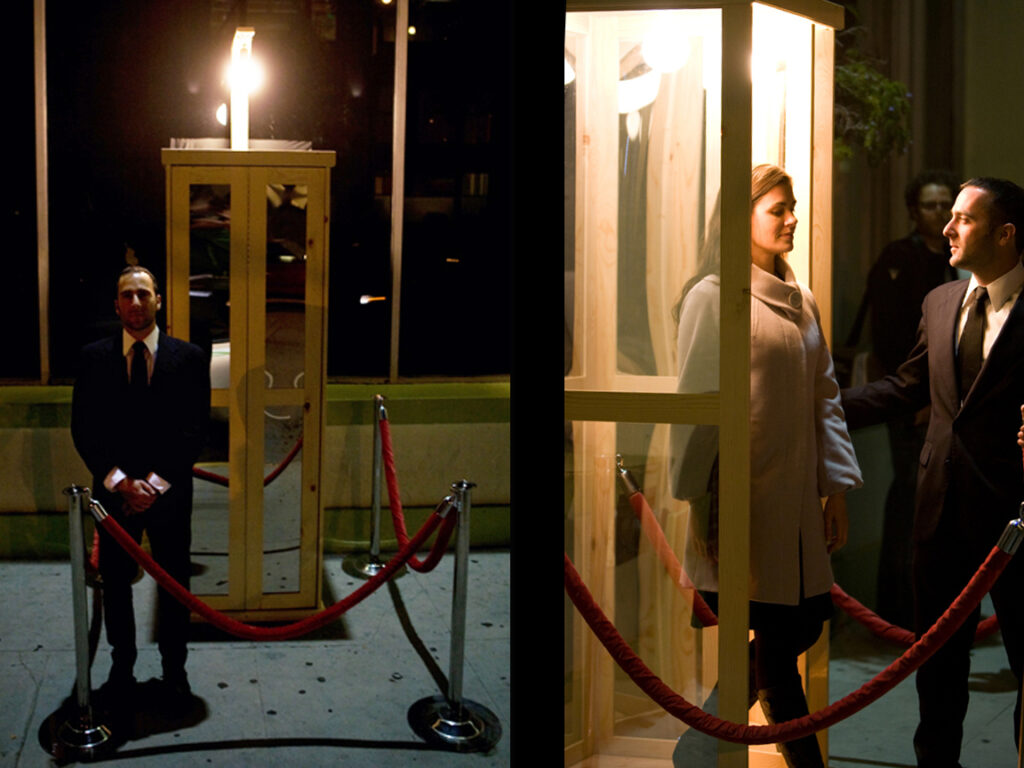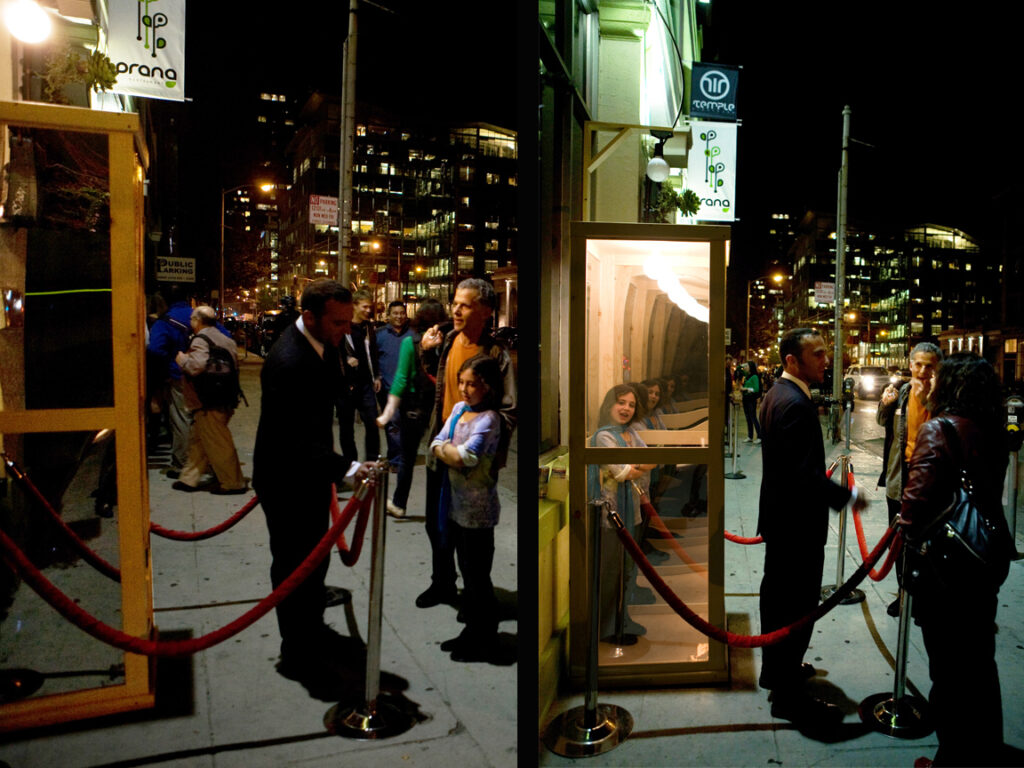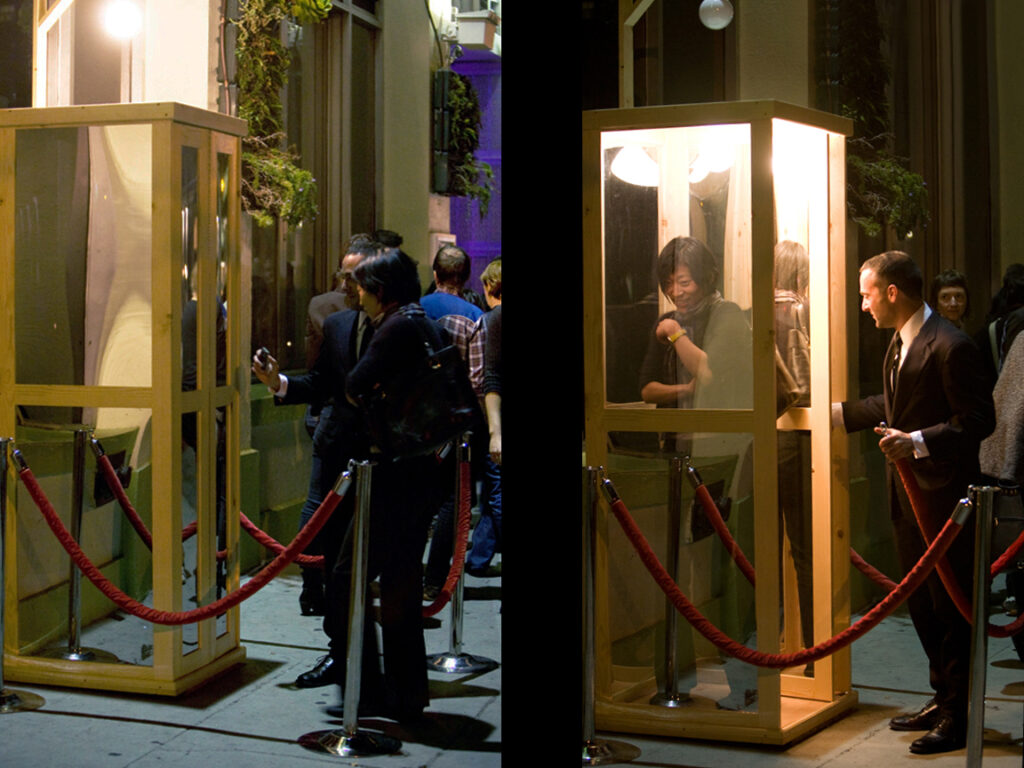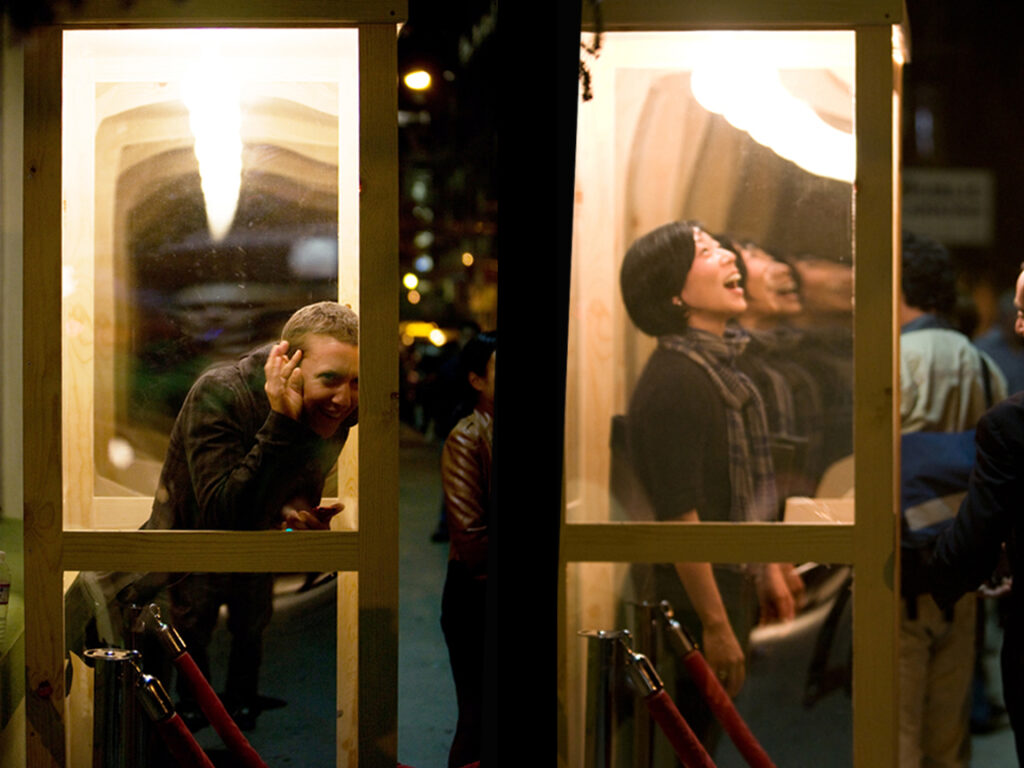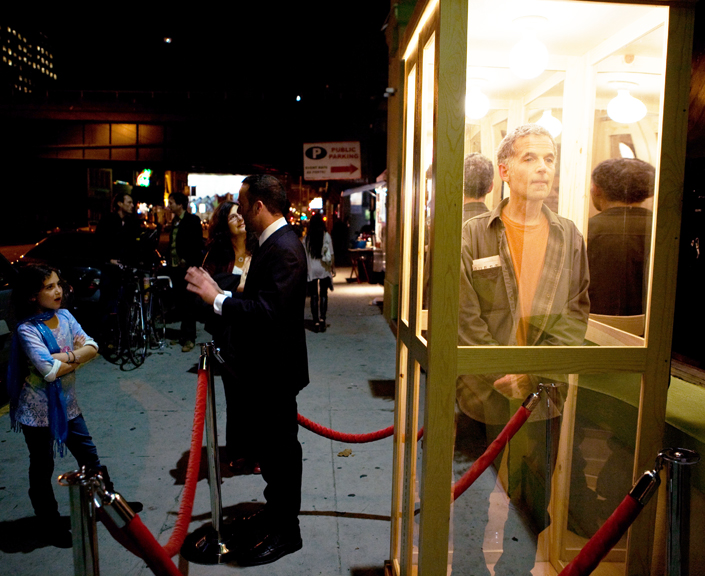The Oracle, San Francisco, CA, October, 2009
This was the final project in the Yoga Teacher Series. It was originally contracted by The Thing Quarterly as their contribution to The San Francisco Film Societies Cinema By The Bay opening party in October of 2009. I also performed this piece two more times in Los Angeles for the Charlie James Gallery in 2010.
Several months ago I began a study of how to predict the future. My initial research yielded mixed results ranging from complete failures to almost interesting (please see Muster and (w)hole for more information.) Although I was able to anticipate in a general sense what people would do in different situations, I was unable to predict with exacting detail the specific and precise course of action that would arise at any particular moment. Through these examinations I found that we are all capable of predicting the future to some extent as each of us follows certain patterns that shape our future experiences in the world. However, life has a way of changing abruptly in ways that our patterns cannot anticipate, and when it does our predictive abilities disintegrate quickly. In the end we all want to know the specific details of the future.
When the word “prediction” is dissected it into its two parts one finds:
pre: meaning “before”
diction: meaning “a word or an utterance of speech.”
This could be taken at face value to mean in a literal sense: “I knew what you were going to say before you said it.” However there seems to be a more potent imbedded meaning to the word, referring to a type of knowledge or insight that comes before language. A type of understanding that cannot be described by thought, word, or action. This type of insight would predate language itself and is literally: knowledge “before the word.”
In modern usage the word “before” can be used to describe the past, present, or future. For example: “What happened before,” “What is before me in the moment,” and “What lies before me down the road.” The structure of our language points out that in order to make a prediction one must have some sort of anticipatory knowledge “before the word.” However, knowing something “before the word” implies that one knows things about the past, present and future simultaneously and insinuates that there is perhaps no difference between the three. To understand this better one only needs to close their eyes and image how we think about time.
When most people close their eyes and think of tomorrow generally a picture is formed that is fragmented, out of focus and scattered, based on the days and months that preceded it. However, when most people close their eyes and remember the past it too appears to be fragmented, distorted and lacking details based on the totality of experiences that each of us has had in our lives. Further, we know that we are capable of observing only a small portion of the things that transpire around us. For instance we cannot see infrared colors, however they exist. We can hear many things but we cannot hear high pitched frequencies like a dog can. We observe very little of what happens around us. So, in some ways our relationship to the present is almost exactly the same as our relationship to the past and future: incomplete, extrapolated, and fragmented. In fact all three appear to be a hazy, out of focus jumble of extrapolated information. Therefore, the reason we can’t see the details of future specifically lies in our inability to see the present with any sort of clarity. As of today, it would seem that we are not capable of seeing with precision the details of the future. However, when a person is faced with something that they are not capable of doing for themselves the smart thing to do is to ask for help.
For thousands of years, when our personal attempts to predict the future fail many have sought the advice of a fortuneteller, profit, or oracle. In ancient Greece people traveled to see the oracle of Delphi. This particular oracle could be found in the temple of Apollo, which historians believe was built over a chasm in the earth. Gases from inside the earth would vent up and induce hallucinogenic visions when inhaled (or so the theory goes). The oracle was always an older townswoman that was chosen to be conduit between Apollo and the humans. She would be placed in a harness near the crack in the earth and breath in the fumes. Fortune seekers would come to ask their questions of the oracle. The answers would typically be cryptic and disjointed. Priests would take the oracles words and form them into poems and these poems were given to the fortune seeker. It was then up to that person to interpret the poems and apply the metaphoric information to their questions. So, the pattern is this: Apollo speaks through the oracle, the oracles words are edited by a priest, the fortune seeker interprets the information and then must find concrete connections that exist in the world to match the prophecies. This movement of information seems like the childhood game of “telephone” where a message becomes more and more convoluted as it is whispered from one child’s ear to the next until all meaning of the original message is lost.
Though the oracle does not directly foretell the future, she does in fact influence the future as the fortune seeker looks for patterns in their life to match the words she foretold. However the fortune seeker still must fill in the blanks for themselves as they begin to shape their future in accordance to the predictions of the oracle. So, in many ways the words of the oracle are not about the future. Instead, they are about shaping the present to coincide with a potential series of events. It would appear that in the end that the fortune seeker becomes their own oracle as it is up to them find the specific answers to their question.
So, why not cut out all the middlemen and create an oracle that would directly allow the fortune seekers to be their own oracle? To do this I made a telephone booth out of wood that was slightly larger than scale. The windows of the booth were constructed out of two-way mirrors instead of panes of glass. When no one was inside the oracle there was a bright light hanging above the booth and people could see their reflections in the booths outside mirrors. As soon as a fortune seeker went into the oracle the light illuminating the outside of the booth turned off and a light inside of the booth went on. When the light inside the booth was activated the person inside was surrounded by mirrored reflections of themselves. However, people watching from the outside were now able to see into the booth and the person within. Simply, from the outside the oracle displayed a vision of the world to the fortune seeker. From within, the oracle exposed the fortune seeker to themselves and to the world outside. I made a perimeter around the oracle out of velvet ropes and stanchions and I escorted people to and from the oracle. If people asked me about how the oracle functioned I did my best to say that my job was only to escort people in and out of the oracle and that it wasn’t my place to say how a fortune seeker was to interact with the oracle (which was themselves). If people were skeptical of my intentions, I outlined the details of my research and previous projects, but by and large I kept the information vague as to not taint the fortune seekers experience. Before people entered the oracle I told them that they could ask anything and that the oracle revealed all. Fortune seekers got one timed minute in the oracle and then I escorted them out.
I would like to thank John Herschend and Will Rogan of The Thing Quarterly for this opportunity and Sean Uyehara of the San Francisco Film Society for all his help and support!!
Lucas Murgida, 10/09.
